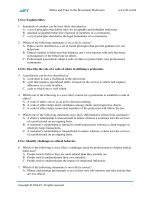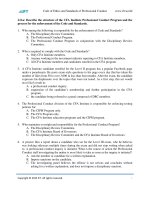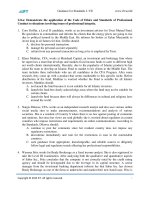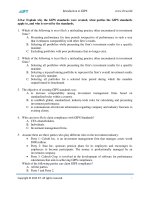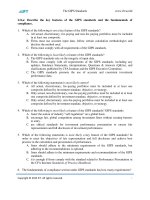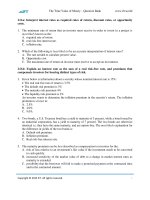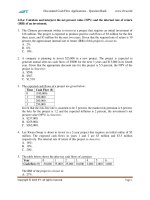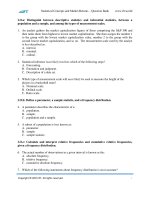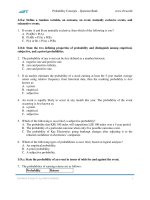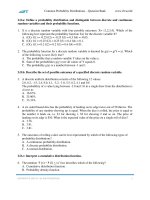CFA 2018 quest bank r14 topics in demand and supply analysis q bank
Bạn đang xem bản rút gọn của tài liệu. Xem và tải ngay bản đầy đủ của tài liệu tại đây (419.2 KB, 18 trang )
Topics in Demand and Supply Analysis – Question Bank
www.ift.world
LO.a: calculate and interpret price, income, and cross price elasticities of demand and
describe factors that affect each measure.
Use the data to answer question 1-3
The market demand function for branded clothes is given by the equation
QDB = 91.70 – 0.7 (PB) + 0.03 (I) + 1.3 (PUB)
Where QDB is the number of branded clothes purchased per month (in thousand USD), PB is the
average price of a branded cloth (in USD), I is the household monthly income (in thousand USD)
and PUB is the average price of an unbranded cloth (in USD). The price of a branded cloth is $20,
monthly income of a family is $70,000, and the price of an unbranded cloth is $15.
1. The income elasticity of demand for branded clothes is closest to:
A. 0.0211.
B. 0.1410.
C. 0.1964.
2. The own-price elasticity of demand for branded cloth is closest to:
A. -0.0211.
B. -0.1410.
C. -0.1964.
3. The cross elasticity of demand for branded cloth is closest to:
A. 0.0211.
B. 0.1410.
C. 0.1964.
4. An analyst makes following statements:
Statement 1: Income elasticity of demand is positive for normal good and negative for
inferior good.
Statement 2: Income elasticity of demand is positive for inferior good and negative for
normal good.
Which of the following is correct?
A. Statement 1 is incorrect and statement 2 is correct.
B. Statement 2 is incorrect and statement 1 is correct.
C. Both statements are incorrect.
5. Two goods whose cross-price elasticity of demand is negative are known as:
A. substitute good.
B. complement good.
C. neither substitute nor complement.
6. Demand for a good is most likely more elastic when:
A. the good is a necessity.
B. the time-frame being considered is long.
C. a small proportion of income is spent on the good.
Copyright © IFT. All rights reserved.
Page 1
Topics in Demand and Supply Analysis – Question Bank
www.ift.world
7. The current price of a product is $10 and the current demand is 10 units. When the price
changes to $7, the quantity demanded increases to 15 units. The price elasticity of demand
for the product is:
A. 1.67.
B. 1.00.
C. 1.35.
Use the data to answer question 8 – 9
The market demand function for branded clothes is given by the equation:
QDB = 91.70 – 0.7(PB) + 0.3(I)
where QDB is the number of branded clothes purchased per month (in thousand USD), PB is the
average price of a branded cloth (in USD) and I is the household monthly income (in thousand
USD). Assume that PB is equal to 20 and I is equal to 30.
8. The demand for branded clothes is closest to:
A. 56.60.
B. 86.70.
C. 114.70.
9. Assume the price is not given, the demand function and the inverse demand function are:
A. QDB = 100.70 – 0.7(PB); PB = 100.70 – 0.7QDB.
B. QDB = 143.85 – 1.43(PB); PB = 143.85 – 1.43QDB.
C. QDB = 100.70 – 0.7(PB); PB = 143.85 – 1.43QDB.
10. Demand for bicycles (QDB), an inferior good, is a function of price of bicycles (PB), price of
petrol (PP), income level (I) and cost of public transportation (CPT). Based on the given
information, which of the following best represents the demand function for bicycles?
A. QDB = 100 – 2.5PB + 1.5PP – 0.5I + 3CPT
B. QDB = 100 – 2.5PB - 1.5PP + 0.5I + 3CPT
C. QDB = 100 -2.5PB + 1.5PP + 0.5I - 3CPT
11. The slope of a demand curve is most often:
A. zero.
B. negative.
C. positive.
12. A high school student’s monthly demand for burgers is given by the equation:
Where
QDBurger is the number of burgers ordered per month
PBurger is the price of a burger
I is his monthly food budget
PPepsi is the price of Pepsi per bottle
If the student’s monthly food budget is $1,000, the price of a burger is $8 and the price of
Pepsi is $1.75 per bottle, then the slope of the demand curve is closest to:
Copyright © IFT. All rights reserved.
Page 2
Topics in Demand and Supply Analysis – Question Bank
www.ift.world
A. -0.90.
B. -1.27.
C. -1.11.
13. Which of the following will result in a movement along the demand curve of a given
product?
A. A change in the cost of producing the product.
B. A change in the price of the product.
C. A change in price of a substitute product.
14. An analyst makes following comments about shifts and movements along the demand curve.
Statement 1: Movement along the demand curve occurs due to a change in the price of a
substitute product.
Statement 2: Demand curve shifts as a result of a change in product’s own price.
Which of the following is most likely true?
A. Statement 1 is correct and statement 2 is incorrect.
B. Statement 2 is correct and statement 1 is incorrect.
C. Both statements are incorrect.
15. Engro Ltd. manufactures steel plates. Iron ore is an important component of raw material
used for manufacturing steel plates. If the price of iron ore decreases, the supply curve for
steel plates will:
A. shift to the left.
B. shift to the right.
C. move upward.
LO.b: compare substitution and income effects.
16. The demand for railway tickets depends on the prices of its substitutes. If the price of air
tickets decreases, the demand curve for railway tickets will:
A. move downward.
B. shift to the right.
C. shift to the left.
17. The market demand function for item A is a function of its price, household income, and the
price of item B.
Own-price elasticity of demand for A
Income elasticity of demand for A
Cross-price elasticity of demand for A with respect to the price of B
–0.65
1.32
0.27
Based on the data given above, which of the following statements is most accurate?
A. Demand for A is elastic.
B. A and B are substitutes.
C. Item A is an inferior good.
Copyright © IFT. All rights reserved.
Page 3
Topics in Demand and Supply Analysis – Question Bank
www.ift.world
18. For Good A, the substitution effect is positive and the income effect is negative; the income
effect is greater than the substitution effect. If the price of Good A decreases, its demand will
most likely:
A. increase.
B. decrease.
C. not change.
19. Which of the following most likely violates the law of demand assuming a decrease in the
price of a product?
A. The negative income effect is greater than the positive substitution effect.
B. The positive income effect is greater than the negative substitution effect.
C. The negative income effect is lower than the positive substitution effect.
LO.c: distinguish between normal goods and inferior goods.
20. The price of a normal good has increased and the purchasing power of consumers has
decreased. The demand for its substitutes will:
A. increase due to income effect.
B. increase due to substitution effect.
C. increase due to both substitution and income effects.
21. When the price falls, income and substitution effects offset each other for which of the
following types of goods?
A. Normal goods.
B. Inferior goods.
C. All goods.
22. If a person’s income increases from $1,000 to $2,000, then his demand for an inferior good
will most likely:
A. increase.
B. decrease.
C. not change.
23. When consumers’ income increases, the demand for a normal good will most likely:
A. not be affected.
B. increase.
C. decrease.
24. When the demand for a good rises due to increase in its own price, the good is most likely a:
A. Normal good.
B. Giffen good.
C. Veblen good.
25. Which of the following statements is incorrect about a Veblen good?
A. They are not inferior goods.
B. Customers see less value in a good as the price of the good increases.
Copyright © IFT. All rights reserved.
Page 4
Topics in Demand and Supply Analysis – Question Bank
www.ift.world
C. In some cases, its demand curve may be positively sloped.
26. Giffen goods are:
A. Inferior goods whose income effect is negative.
B. Status goods whose income effect is positive.
C. Goods with a greater substitution effect than the income effect.
LO.d: describe the phenomenon of diminishing marginal returns.
27. Grey left his job, where he was making $35,000 per annum, to start his own business with an
initial investment of $70,000. He had an option to invest this amount in a friend’s business,
where he would have earned $43,000 per annum. Profit and loss statement for first year of
Grey’s business is given below.
Total revenue
Cost of raw
material
Wages paid to
employees
Interest on debt
$200,000
$15,000
$20,000
$3,000
What is the economic profit for Grey’s business in the first year?
A. $14,000.
B. $84,000.
C. $132,000.
28. Two analysts discussing accounting and economic profits made the following statements.
Statement 1: Accounting profit is book profit based on revenue and cost. It does not consider
cost of borrowing and cost of equity. Economic profit considers cost of borrowing as well as
cost of equity.
Statement 2: Accounting profit is book profit based on revenue and cost. It considers cost of
borrowing but does not consider cost of equity. Economic profit considers both cost of debt
as well as cost of equity.
Which statement(s) is least likely correct?
A. Statement 1.
B. Statement 2.
C. Both.
29. Maple’s total revenue is $98,000, explicit cost is $50,000, and normal profit is $10,000.
Implicit cost of the company is most likely:
A. $38,000.
B. $48,000.
C. $10,000.
30. Normal profit is equal to:
A. positive economic profit.
B. total revenue minus all explicit costs.
Copyright © IFT. All rights reserved.
Page 5
Topics in Demand and Supply Analysis – Question Bank
www.ift.world
C. accounting profit minus economic profit.
31. Which of the following is most likely a characteristic of perfectly competitive market?
A. Average revenue > Marginal revenue, all units are sold at a decreasing marginal price.
B. Average revenue = Marginal revenue, all units are sold at an equal marginal price.
C. Average revenue < Marginal revenue, all units are sold at an increasing marginal price.
32. An analyst makes the following comments about imperfect competition:
Statement 1: Both average revenue and marginal revenue decrease with each successive unit
sold. Average revenue decreases more than marginal revenue. Marginal revenue is more than
average revenue.
Statement 2: Both average revenue and marginal revenue decrease with each successive unit
sold. Marginal revenue decreases more than average revenue. Average revenue is more than
marginal revenue. Which statement is most likely correct?
A. Statement 1.
B. Statement 2.
C. None.
33. Total revenue is maximized when:
A. average revenue becomes zero.
B. average revenue equals marginal revenue.
C. marginal revenue becomes zero.
34. The sales manager of a British medical equipment manufacturer estimates that the firm can
sell 1,000 units of BP monitor and earn a total revenue of GBP 4,000,000. However, if 1,250
units are sold, the total revenue will be GBP 4,800,000. The marginal revenue per unit for
selling 1,250 units of BP monitor instead of 1,000 units is closest to:
A. GBP 3200.
B. GBP 4000.
C. GBP 4500.
35. A dairy farm operating in a perfectly competitive market, supplies milk to Dane Inc.,
manufacturers of sweet yoghurt and milk-based frozen desserts. What will be the most likely
impact if the farm increases its milk production and unit sales by 15%?
A. a 15% increase in average revenue.
B. an increase in total revenue of less than 15%.
C. a 15% increase in total revenue.
36. Dreamworld, a chain of movie theaters, is offering weekday morning shows at discounted
prices. If the tickets are priced at $25 per show, then 400 customers are expected each
weekday for the morning shows. But, if the tickets are offered at a discount price of $20 per
show, then 600 customers are expected each weekday for the morning shows. The marginal
revenue per customer earned from offering the discounted price is closest to:
A. $5.
B. $10.
C. $40.
Copyright © IFT. All rights reserved.
Page 6
Topics in Demand and Supply Analysis – Question Bank
www.ift.world
37. For a firm operating under perfective competition, the marginal revenue per unit sold is most
likely:
A. equal to average revenue.
B. less than average revenue.
C. greater than average revenue.
38. Healthpro Inc. produces health supplements. Total fixed and variable costs of the company
are $250,000 and $260,000 respectively. Total fixed cost is constant up to a certain range, but
can change to another constant level when production moves outside of that range. This type
of fixed cost is termed as:
A. marginal fixed cost.
B. average fixed cost.
C. quasi-fixed cost.
39. When MC intersects ATC and AVC:
A. ATC and AVC start decreasing.
B. ATC and AVC do not change.
C. ATC and AVC start increasing.
40. The table below gives the cost structure of a company.
Output of goods
0
7
15
21
26
30
Labors
Employed
0
1
2
3
4
5
TFC Wage Rate
AFC AVC
ATC
35
35
35
35
35
35
5.00
2.33
1.67
1.35
1.17
9.29
6.33
5.95
5.96
6.17
30
30
30
30
30
30
4.29
4.00
4.29
4.62
5.00
Based on the data above, when production increases from 21 to 26 units of goods, the
marginal cost per unit of production is closest to:
A. 5.0.
B. 6.0.
C. 7.5.
The following information relates to Questions 41 – 43
The table below summarizes the cost structure of a firm for various levels of output of a product:
Quantity
(Q)
0
2
4
Total Fixed
Cost
(TFC)
540
540
540
Copyright © IFT. All rights reserved.
Total Variable
Cost
(TVC)
0
200
300
Page 7
Topics in Demand and Supply Analysis – Question Bank
6
8
10
540
540
540
www.ift.world
400
500
550
41. If the firm produces 6 units, the average fixed cost (AFC) is closest to:
A. 60.
B. 75.
C. 90.
42. When the firm increases production from 6 to 8 units, the marginal cost per unit (MC) is
closest to:
A. 50.
B. 75.
C. 100.
43. The number of units that results in the lowest average total cost (ATC) is closest to:
A. 6.
B. 8.
C. 10.
44. Newage Inc. is operating in a perfectly competitive market. AVC for the firm is $33, ATC is
$45 and AR is $38. The firm should:
A. operate in both the short run and the long run.
B. operate in the short run, but exit in the long run.
C. shut down in the short run and exit the market in the long run.
45. Spacelight Inc. is operating under imperfect competition. Total cost for the firm is $64, total
variable cost is $54 and total revenue is $60. The firm should:
A. operate in the short run, but exit in the long run.
B. shut down in the short run, but can operate in the long run.
C. operate in the short run as well as in the long run.
LO.e: determine and describe breakeven and shutdown points of production.
46. Under perfect competition, which of the following statements regarding the breakeven point
is least likely accurate? The breakeven point is the quantity where:
A. Total revenue equals total costs.
B. Total revenue exceeds total costs.
C. Price and marginal revenue equal average total cost.
47. Under perfect competition, which of the following statements regarding short-term shutdown
point is most likely accurate? Shutdown point is:
A. When average revenue is less than average variable costs.
B. Below which a firm may continue to operate in the long run as long as it covers variable
costs.
C. The quantity below which price is greater than the average variable cost.
Copyright © IFT. All rights reserved.
Page 8
Topics in Demand and Supply Analysis – Question Bank
www.ift.world
48. When total revenue is less than total variable costs, the company will most likely:
A. shut down production to zero.
B. stay in the market in the short-run.
C. continue production in the short run and shut down to zero in the long run.
49. A firm operates in a perfectly competitive market. What is the level of MR and MC beyond
which total profit may remain positive but cannot be maximized?
A. When MR < MC.
B. When MR = MC.
C. When MR > MC.
50. An analyst makes the following statements:
Statement 1: Profit maximization can be identified with two methods. When MR = MC or
when the difference of TR and TC is maximum.
Statement 1: Profit maximization can be identified with only one method. Profit is
maximized when difference of TR and TC is maximized.
Which statement is least likely correct?
A. Both.
B. Statement 1.
C. Statement 2.
51. Profit maximization most likely occurs when:
A. Average total cost is minimum.
B. Marginal revenue is greater than marginal cost.
C. The difference between total revenue and total costs is the most.
LO.f: describe how economies of scale and diseconomies of scale affect costs.
52. A firm in perfect competition has a total output of 100 units, which is the point of minimum
efficient scale. It means that:
A. at this point economies of scale are maximum and diseconomies of scale are minimum.
B. at this point diseconomies of scale are maximum and economies of scale are minimum.
C. information is insufficient to identify the level of economies and diseconomies of scale at
this point.
53. Long term average cost of production is decreasing due to labor specialization, mass
production, and better technology and equipment. This situation is best termed as:
A. diminishing marginal returns to scale.
B. economies of scale.
C. diseconomies of scale.
54. The output of Abel Inc. increases by a larger percentage than the increase in inputs. Abel is
most likely experiencing:
A. economies of scale.
B. diseconomies of scale.
Copyright © IFT. All rights reserved.
Page 9
Topics in Demand and Supply Analysis – Question Bank
www.ift.world
C. constant returns to scale.
55. Current market price of a pack of A4 size paper is $7, which is below minimum efficient
scale along the long-run average total cost curve (LRATC). Price at minimum efficient scale
is $9. What will be the most likely price movement in the long run? Price will:
A. remain stable at $7.
B. go down to $5.
C. go up to $9.
56. In the short run, auto industry is earning positive economic profit. As a result, firms increased
their scale of production to earn higher profits. What will be the most likely effect?
A. The short run average total cost curve will shift to the minimum efficient scale. The
prices will increase and in the long run firms will earn zero economic profit.
B. The short run average total cost curve will shift to the minimum efficient scale. The
prices will decrease and in the long run firms will earn zero economic profit.
C. The short run average total cost curve will shift to the minimum efficient scale. The
prices will remain stable and in the long run firms will earn zero economic profit.
57. Ali Enterprises is operating in a perfectly competitive environment. Which of the following
actions is best for Ali Enterprises to take in order to stay in the market in the long run?
A. Operate at any point beyond the minimum efficient scale point on the LRATC to lower
costs.
B. Operate at the minimum efficient scale point on the long run average total cost curve
(LRATC).
C. Maintain the current level of production.
58. Under perfect competition, what will a firm least likely earn in the long run?
A. Normal profits.
B. Zero economic profit.
C. Positive economic profit.
59. Three analysts made the following comments about labor productivity.
Analyst 1: Total labor productivity is the most useful measure for analyzing labor
productivity as it considers total output per total labor employed.
Analyst 2: Average labor productivity is the most useful measure for analyzing labor
productivity as it considers overall efficiency of labor.
Analyst 3: Marginal labor productivity is the most useful measure for analyzing the labor
productivity as it considers addition to total product from increasing one more unit of labor.
Which analyst is most likely correct?
A. Analyst 1.
B. Analyst 2.
C. Analyst 3.
60. The point at which the benefit of employing one more labor starts to decrease is most likely
termed as:
A. decreasing marginal productivity of labor.
Copyright © IFT. All rights reserved.
Page 10
Topics in Demand and Supply Analysis – Question Bank
www.ift.world
B. declining marginal productivity of labor.
C. diminishing marginal productivity of labor.
The following information relates to Questions 61–62
The Production Manager of a manufacturing company has gathered the following information:
Labor (L)
Total Product (TP)
0
0
1
175
3
450
5
600
7
675
9
700
61. The level of labor at which the average product of labor is highest is closest to:
A. 1.
B. 3.
C. 5.
62. As labor is added, the firm experiences increasing returns. The number of workers where
increasing marginal returns turn to diminishing marginal returns is closest to:
A. 0.
B. 1.
C. 3.
63. A manufacturing firm wants to achieve the most efficient combination of labor and capital.
What should the firm most likely do to minimize total costs for a desired level of output? It
should equalize the:
A. marginal product per unit of capital to the marginal product per unit of labor.
B. average product of capital to the average product of labor.
C. marginal product per dollar spent on capital to the marginal product per dollar spent on
labor.
64. A firm plans to expand production by 500 units. The marginal product per day for one
additional unskilled laborer is 250 units and one additional skilled worker is 500 units.
Wages per day are £150 for an unskilled labor and £280 for a skilled worker. The firm should
hire:
A. two additional unskilled laborers.
B. one additional skilled worker.
C. either a skilled worker or two unskilled laborers.
65. An American firm employs unskilled, semi-skilled, and skilled labor in a cost-minimizing
mix at its manufacturing plant. The current wage of unskilled labor is $100 per day and the
Copyright © IFT. All rights reserved.
Page 11
Topics in Demand and Supply Analysis – Question Bank
www.ift.world
government passes a law that requires the minimum wage to be $150 per day. The marginal
product of unskilled labor is lower than semi-skilled and skilled labor. Since the equilibrium
wages for semi-skilled and skilled labor exceed the minimum wage, they are not affected by
the new law. Which of the following actions will the firm most likely take in response to the
imposition of the minimum wage law?
A. Employ fewer unskilled workers at its plant.
B. Employ more unskilled workers at its plant.
C. Retain the current mix of unskilled, semi-skilled, and skilled workers.
66. A firm is using two inputs 1 and 2 and wants to determine the profit-maximizing utilization
level of an input. The firm’s cost of an input:
A. is maximized when MP1/P1 = MP2/P2.
B. is minimized when MP1/P1 = MP2/P2.
C. does not change when MP1/P1 = MP2/P2.
67. Milkyway produces food colors. All the inputs mentioned can substitute each other. What
input type should the firm use when expanding output for maximizing profitability?
Input
Natural color extract
Artificial chemicals
Artificial color mixture
MP
450
300
600
Resource Price/Unit
450
270
800
A. Natural color extract.
B. Artificial color mixture.
C. Artificial chemicals.
The following information relates to Questions 68–69
A Pakistani firm makes lanterns, employing both skilled craftsmen and automated equipment in
its plant. The selling price for a lantern is PKR 3,000. A craftsman earns PKR 10,000 per week
and can produce ten lanterns per week. On the other hand, a machine leased for PKR 12,000 per
week can produce ten lanterns per week.
68. If the firm hires an additional craftsman, then the marginal revenue product (per week) will
be closest to:
A. PKR 30,000.
B. PKR 32,000.
C. PKR 40,000.
69. The firm plans to increase the weekly production to 40 lanterns. The firm would most likely
maximize profits by:
A. hiring additional craftsmen.
B. leasing additional machine.
C. neither of the above since it is not viable for the firm to produce additional lanterns.
Copyright © IFT. All rights reserved.
Page 12
Topics in Demand and Supply Analysis – Question Bank
www.ift.world
Solutions:
1. A is correct. The income elasticity of demand is given by (∆QDB/∆I) * (I/QDB), and notice
from the demand function that ∆QDB /∆I = 0.03. Use the demand equation for calculating
QDB.
QDB = 91.70 – 0.7 (PB) + 0.03 (I) + 1.3 (PUB)
QDB = 91.70 – 0.7 (20) + 0.03 (70) + 1.3 (15) = 99.3
Inserting in the values for I and QDB yields income elasticity of (0.03) (70/99.3) = 0.0211.
2. B is correct. The own-price elasticity of demand is given by (∆QDB/∆PB) (PB/Q), and notice
from the demand function that ∆QDB/∆PB = −0.7. Inserting the given variable values into the
demand function yields QDB = 99.3. So at a price of $20, the own-price elasticity of demand
equals (–0.7) (20/99.3) = −0.1410.
3. C is correct. The cross-price elasticity of demand is given by (∆QDB/∆PUB) (PUB/QDB), and
notice from the demand function that ∆QDB/∆PUB = 1.3. Inserting in the values for PUB and
QDB yields a cross-price elasticity of demand for branded clothes of (1.3) (15/99.3) = 0.1964.
4. B is correct. Income elasticity of demand is positive for normal goods and negative for
inferior goods. When income increases, the consumption of a normal good rises but the
consumption of an inferior good decreases.
5. B is correct. Two goods whose cross-price elasticity of demand is negative are known as
complements.
6. B is correct. The longer the time elapsed since a price change, the more elastic the demand is.
For example, if gasoline (petrol) prices rise, consumers cannot quickly change their mode of
transportation, but will be likely do so in the long run.
7. A is correct. The price elasticity of demand is the ratio of percentage change in demand and
percentage change in price. Price elasticity of demand = (15 – 10)/10 ÷ (7 – 10)/10 = -1.67.
Any value above 1.0 in absolute terms indicates high elasticity.
8. B is correct.
QDB = 91.70 – 0.7 (PB) + 0.3 (I)
QDB = 91.70 – (0.7) (20) + (0.3) (30)
QDB = 86.70
9. C is correct.
Demand
function
QDB = 91.70 – 0.7 (PB) +
0.3 (I)
QDB = 91.70 – 0.7 (PB) +
(0.3) (30)
QDB = 100.70 – 0.7 (PB)
Copyright © IFT. All rights reserved.
Inverse Demand
function
QDB = 100.70 – 0.7 (PB)
0.7 (PB) = 100.70 – QDB
PB = 143.85 – 1.43QDB
Page 13
Topics in Demand and Supply Analysis – Question Bank
www.ift.world
10. A is correct. Demand function based on the given information is QDB = 100 – 2.5PB + 1.5PP –
0.5I + 3CPT. Demand of bicycles is inversely related to its own price and income level and it
is proportionately related to the cost of public transportation and the price of petrol.
11. B is correct. The demand curve is generally downward sloping (negative slope) because of
the inverse relationship between the price of a product and its quantity demanded.
12. C is correct. Substituting the given values in the demand function, we have:
QDBurger= 15 – 0.90 PBurger + 0.006 * $1000 – 0.60 * 1.75 = 19.95 – 0.90 PBurger,
Demand curve or inverse Demand function: PBurger = 22.17 – 1.11 QDBurger
13. B is correct. When a good’s own-price changes, quantity demanded changes; this is called a
movement along the demand curve.
14. C is correct. Movement along the demand curve occurs due to a change in product’s own
price. Demand curve shifts as a result of a change in price of a substitute product.
15. B is correct. When the price of iron ore decreases, the cost of production will come down.
This will shift the supply curve to the right.
16. C is correct. A decrease in the price of air tickets will decrease the demand for railway
tickets, which will shift the demand curve for railways tickets to the left.
17. B is correct. The cross-price elasticity is positive, which implies that as the price of B
increases, more of A is demanded, making A and B substitutes.
18. B is correct. In the special case of a Giffen good, the negative income effect will be greater
than the positive substitution effect; this means that for a Giffen good, a decrease in the price
of Good A will cause a decrease in its consumption.
19. A is correct. In the special case of a Giffen good, the negative income effect will be greater
than the positive substitution effect; this means that for a Giffen good, a decrease in the price
of Good A will cause a decrease in its consumption. It’s a violation of the law of demand.
20. C is correct. When the price of a normal good increases, the demand for its substitutes will
increase due to both substitution and income effects.
21. B is correct. If the price of a normal good decreases, both the substitution and income effects
lead to an increase in the quantity demanded. If the price of a good falls and income and
substitution effect offset each other, then it is an inferior good.
22. B is correct. When income increases, the demand for an inferior good decreases.
23. B is correct. When income increases, the demand for a normal good increases.
Copyright © IFT. All rights reserved.
Page 14
Topics in Demand and Supply Analysis – Question Bank
www.ift.world
24. C is correct. Veblen goods are generally considered a status symbol. An increase in the price
of a Veblen good leads to an increase in the quantity demanded.
25. B is correct. Veblen goods offer more value to the consumer when the price of the good
increases.
26. A is correct. Veblen goods are not inferior goods, whereas Giffen goods are. An increase in
income for consumers of a Veblen good leads to an increase in the quantity purchased at each
price. The opposite is true for a Giffen good.
27. B is correct. Economic profit = Accounting profit – Total implicit costs
= 162,000 – 43,000 – 35,000
= $84000
28. A is correct. Accounting profit is book profit based on revenue and cost. It includes cost of
borrowing as interest expenses, but it does not consider the opportunity cost of the owner’s
capital.
29. C is correct. Normal profit is the level of accounting profit needed to just cover the implicit
opportunity costs ignored in accounting costs. Normal profit can be considered as the cost of
capital or implicit costs in money terms.
30. C is correct. Accounting profit = Economic profit + Normal profit.
31. B is correct. In a perfectly competitive market, all units are sold at an equal price and average
revenue is equal to marginal revenue.
32. B is correct. In imperfect competition, both average and marginal revenue decrease with each
successive unit sold. The decrease in marginal revenue is more than average revenue.
33. C is correct. Total revenue is maximized when marginal revenue becomes zero.
34. A is correct.
Change in total revenue = GBP 800,000
Change in total units sold = 250. Marginal revenue =
.
= GBP 3200.
35. C is correct. Since it is a perfectly competitive market, the 15% increase in supply by a single
firm will not affect the price. The increase in units sold by the farm will be matched by a
15% increase in revenue.
36. B is correct.
.
Change in total revenue per day = [(600 * $20) – (400 * $25)] = 2,000
Change in units sold = (600 – 400) = 200
Marginal revenue =
= $10.
Copyright © IFT. All rights reserved.
Page 15
Topics in Demand and Supply Analysis – Question Bank
www.ift.world
37. A is correct. A firm is a price taker under perfect competition; it cannot change the price at
any quantity supplied to the market. AR = MR = Price.
38. C is correct. Quasi-fixed cost is fixed up to a certain range, but can change to another
constant level when production moves outside of that range.
39. C is correct. MC intersects ATC and AVC at their minimum, after that ATC and AVC start
increasing.
40. B is correct. Marginal cost of production = ∆TC/∆Q
For increase in output from 21 to 26 marginal cost = (155 - 125) / (26 - 21) = 6.00
41. C is correct.
42. A is correct.
= 90.
.
43. C is correct. When the number of units produced is 10, the average total cost is 109, which is
the lowest.
.
44. B is correct. When AR is less than ATC, but more than or equal to AVC, the firm should
continue to operate in the short run but must exit in the long run.
45. A is correct. When total revenue is less than total cost and more than total variable cost, the
firm should continue to operate in the short run but should exit in the long run.
46. B is correct. Under perfect competition, the breakeven point is the quantity where price,
average revenue, marginal revenue and average total cost are equal. It is also the quantity
where total revenue equals total costs.
47. A is correct. Under perfect competition, the short-term shutdown point is when average
revenue is less than average variable costs. B is incorrect because a firm must cover all costs
in the long run to stay operational, including fixed and variable costs. C is incorrect because
for any quantity below the shutdown point, price is less than the average variable cost.
48. A is correct. When total revenue is enough to cover total variable costs, but not total fixed
costs, the firm will stay in the market in the short run. If it is not able to meet variable costs,
then it will shut down production to zero in the short-run and exit the market in the long run.
49. B is correct. When MR = MC, profit is maximized, beyond this point profit may be positive
but it cannot be maximized.
50. C is correct. There are two methods for identifying profit maximization level. 1) When MR =
MC and 2) when the difference between TR and TC is maximized.
Copyright © IFT. All rights reserved.
Page 16
Topics in Demand and Supply Analysis – Question Bank
www.ift.world
51. C is correct. The quantity at which average total cost is minimized does not necessarily
correspond to a maximum profit. Profit maximization occurs when marginal revenue equals
marginal cost, and the difference between TR and TC is the greatest.
52. A is correct. Minimum efficient scale is the point at which economies of scale are maximized
and diseconomies of scale are minimized.
53. B is correct. When the long term average cost decreases due to labor specialization, mass
production, technological advances, and better equipment, it is known as economies of scale.
54. A is correct. When output increases by a greater proportion than the increase in inputs, the
company is said to be experiencing economies of scale. C is incorrect because constant
returns to scale occur when the output increases in the same proportion as input with no
increase in per-unit cost.
55. C is correct. Lower than equilibrium market price will result in losses to producers and they
will exit. This decrease in supply will increase price to new equilibrium level.
56. B is correct. The short run average total cost curve will shift to the minimum efficient scale.
The prices will decrease and in the long run firms will earn zero economic profit.
57. B is correct. The firm operating beyond the long-run efficient scale is subject to
diseconomies of scale. It should decrease its level of production to stay in the market.
58. C is correct. Under prefect competition, a firm only earns normal profit in the long run as
competition drives prices down to long-run marginal cost. Economic profit is zero.
59. C is correct. Marginal productivity of labor shows addition to the total product due to
addition of one more unit of labor. This gives a better picture and shows changes in output
for increase in one unit of labor.
60. C is correct. The point at which, the benefit of employing one more labor starts to decrease is
termed as diminishing marginal product of labor.
61. A is correct.
Average product of 3 workers =
. Average product of one worker is 175.
= 150. Average product of 5 workers = 600/5 = 120. It is
the highest for 1 worker.
62. B is correct. Marginal product =
. The increase in MP from 0 to 1 worker
is 175. This is the only point where marginal product increases.
Copyright © IFT. All rights reserved.
Page 17
Topics in Demand and Supply Analysis – Question Bank
www.ift.world
63. C is correct. Costs are minimized when substitution of capital for labor does not result in any
cost savings, which is the case when the marginal product per dollar spent is equalized across
the inputs.
64. B is correct. The firm will minimize costs at the higher level of production by hiring one
additional skilled worker at a total cost of £280.
65. A is correct. The firm employs labor of various types in a cost-minimizing combination.
Profit is maximized when marginal revenue product is equalized across each type of labor
input. If the wage rate of unskilled workers increases, the marginal product produced per
dollar spent to employ unskilled labor will decline. The original employment mix is no
longer optimal, so the firm will respond by shifting away from unskilled workers to workers
whose wages are unaffected by the minimum wage law.
66. B is correct. When MP1/P1 = MP2/P2, cost of inputs is minimized.
67. C is correct. The firm minimizes cost and enhances profitability by using artificial chemical
as it has the highest ratio of MP to input price (MP/P = 300/270 = 1.11).
68. A is correct. The marginal revenue product is the marginal product of an additional craftsman
(10 tables) times the price per table (PKR 3,000). Therefore, 10 * PKR 3,000 = PKR 30,000.
69. A is correct. The firm would most likely enhance profits by hiring additional craftsmen. The
cost of hiring a craftsman is lower than the equipment. However, both produce the same
quantity.
Copyright © IFT. All rights reserved.
Page 18
